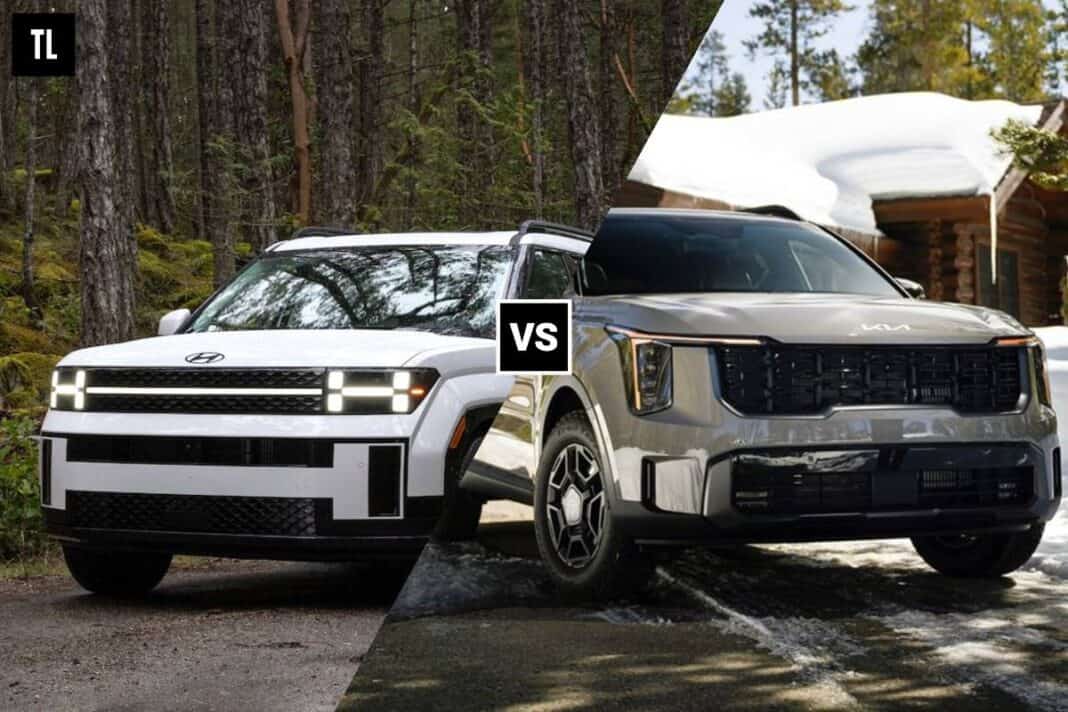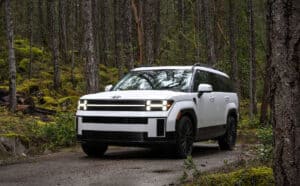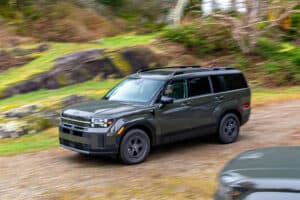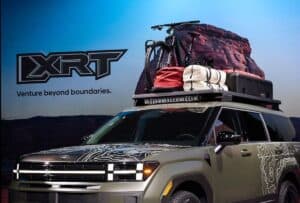Kia gave its Sorento SUV a mid-cycle refresh for the 2024 model year. The changes included exterior and interior design updates, extra standard equipment, and some new features, notably the adoption of dual 12-inch screens in the dashboard. With so many strong contenders jostling for position in the mid-size SUV segment, the updates help to keep the Sorento competitive against its rivals—not least of which is the Hyundai Santa Fe, which was completely renewed for the 2024 model year.
Mechanically, the Sorento and Santa Fe have long been closely related. Now that the Santa Fe once again offers three rows of passenger seating, as the Sorento has always done, they’re arguably closer rivals than ever. We spent a few days with a Sorento X-Line Limited, and re-familiarized ourselves with the Santa Fe, to see how the two match up.
Our Sorento X-Line Limited test car had a Canadian MSRP of C$50,975 (US$46,390 for the equivalent X-Line SX Prestige). The Santa Fe we drove was a range-topping Ultimate Calligraphy (just ‘Calligraphy’ in the USA), priced at C$54,799 (US$46,500).
Related – First Drive: 2024 Hyundai Santa Fe Ultimate Calligraphy Review
Performance and Driving Impressions
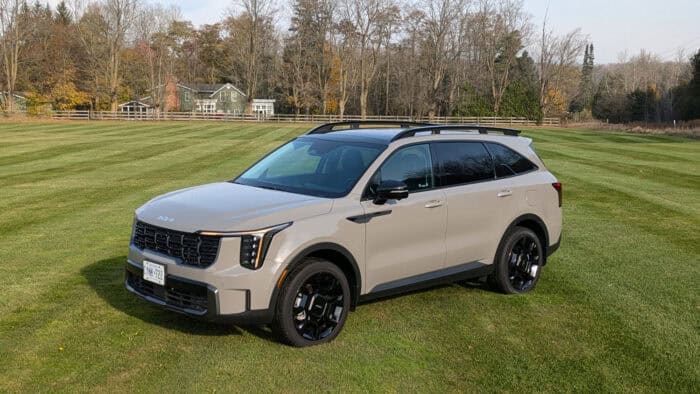
| Spec | 2024 Kia Sorento X-Line | 2024 Hyundai Santa Fe Ultimate Calligraphy |
|---|---|---|
| Engine | 2.5L Turbocharged Inline-4 | 2.5L Turbocharged Inline-4 |
| Horsepower | 281 hp | 277 hp |
| Torque | 311 lb-ft | 311 lb-ft |
| Transmission | 8-Speed Dual-Clutch Automatic | 8-Speed Dual-Clutch Automatic |
| Drivetrain | All-Wheel Drive (AWD) | All-Wheel Drive (AWD) |
| Towing Capacity | 3,500 lbs | 3,500 lbs |
The X-Line Limited gives you lots of the rugged style of the pricier X-Pro, including the 33mm (1.3-inch) raised ride height, but without its all-terrain tires. Our Sorento had AWD to help when things got slippery, but with all-season tires as standard, you probably won’t want to tackle anything much more challenging than the wet field where we shot these photos.
Just like the Santa Fe Ultimate Calligraphy, the X-Line has a 2.5-litre turbo engine. Other trims have hybrid or plug-in hybrid options, but not the X-Line. A conventional, floor-mounted shifter for the eight-speed automatic transmission is less common than it was, but you get one here – perhaps to avoid interfering with the clean lines of the dash. The Santa Fe’s solution is a column shift.

The Sorento is easy to drive and handles predictably. There’s the torque you’d expect from a turbocharged engine and it’s quiet enough in the cruise. Ride comfort is adequate on the 20-inch rims – no worse than the Sorento’s rivals, but not noticeably better either, nor much different to the Santa Fe we drove on 21-inch wheels. Auto makers have long since abandoned outright ride comfort in favour of stylish wheel designs, in our opinion. The towing capacity of both cars as tested is 3,500 lb (1,588kg).
Related – Kia’s Mid-Size Sorento SUV Adds New Hybrid-Powered Model for 2022
Interior
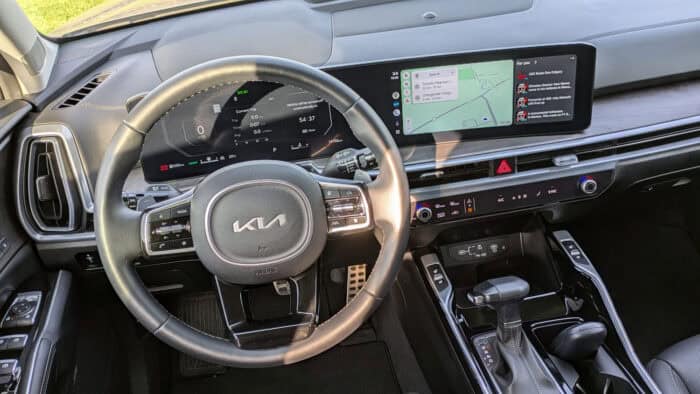
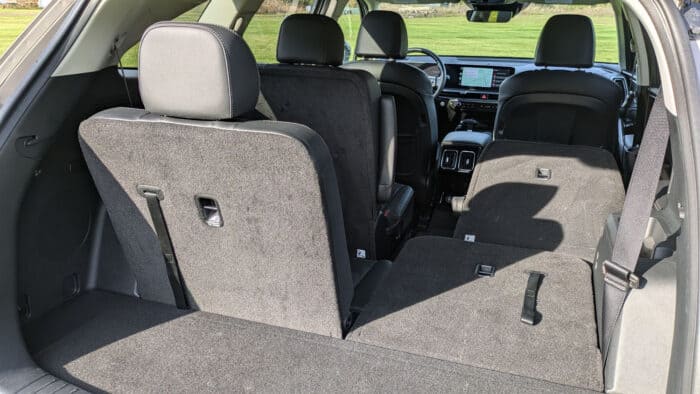
The Sorento X-Line Limited boasts two 12-inch screens that combine to form a panoramic display. It’s a high-end look for a family SUV. The interface is intuitive, and the infotainment incorporates a quality Bose audio system. We’re still unconvinced by the use of haptic controls for the HVAC, though.
The trim materials, including satin metal accents, have a high-quality feel, while the door handles are satisfyingly chunky. The driver and passenger seats are supportive. Behind them are two captain’s chairs with fabulous legroom (a three-passenger bench is available in other grades). When you don’t need them, they fold electrically. Further rearward is a third row that will suffice for a couple of younger children but – despite good headroom – won’t be a great fit for anyone with longer legs.

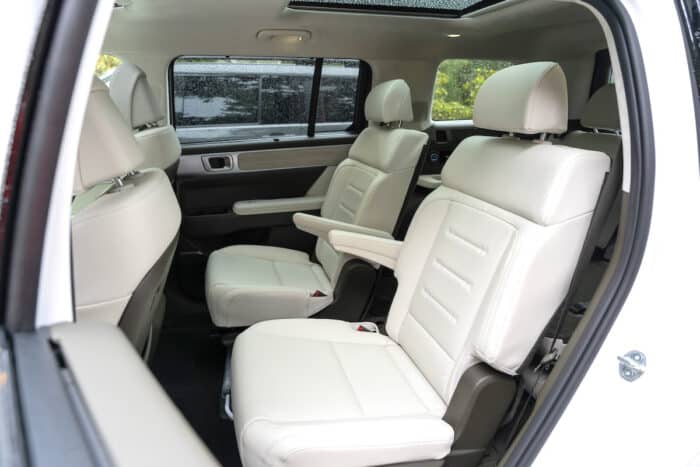
It’s no surprise that the Santa Fe likewise gets the twin-12-inch displays as part of a notably sleek and stylish interior. The Ultimate Calligraphy we drove layers on the luxury with features like Nappa leather, a UV sterilization tray and relaxation seats.
In practical terms, the passenger accommodation is similar to the Sorento’s, as you’d expect from two cars that share a common architecture and wheelbase. But the Santa Fe’s vertical tailgate unlocks a little more cargo space, especially with the third-row seating in place, and provides a wide opening for loading.
Styling
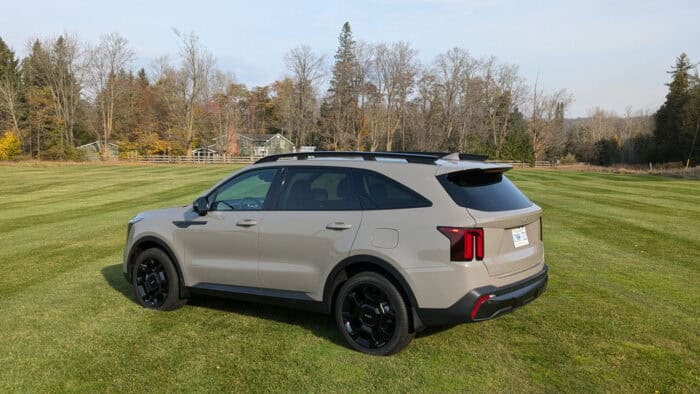

For the biggest difference between the Kia Sorento and the Hyundai Santa Fe, look no further than the two SUVs’ exterior styling. The Kia has handsome, chunky, modern, but conventional looks that you might struggle to pick out at first glance in a crowded parking lot. Not so the Santa Fe, which has embraced square corners and stronger geometric shapes to realize one of the most distinctive SUVs on the road. And the Santa Fe XRT adds even more style. Ironically, it reminds us a little of the Kia EV9. The Santa Fe is attractive, but in a different way to the Sorento, and we think it is more likely to polarize opinion than the Kia.
Our Sorento X-Line Limited was finished in fashionable, outdoorsy Wolf Grey paint (C$250 / US$495) while the top-of-the-line Santa Fe’s Earthy Brass matte (an astonishing C$1,500 / US$1,000 extra) served to accentuate its sharper edges.
Takeaway: Two Great SUVs, No Clear Loser
Kia Sorento X-Line Limited
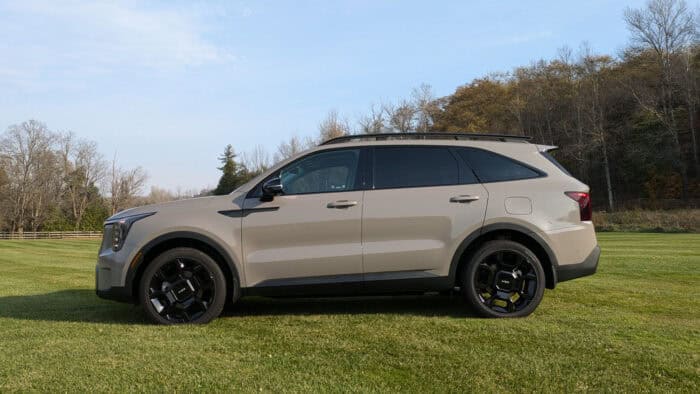
Pros
- More compact than many other three-row options
- Attractive and spacious
- Great value, especially in lower grades
Cons
- More fuel-efficient powertrains available
- No need for huge wheels
- Controls need more physical buttons
Hyundai Santa Fe Ultimate Calligraphy
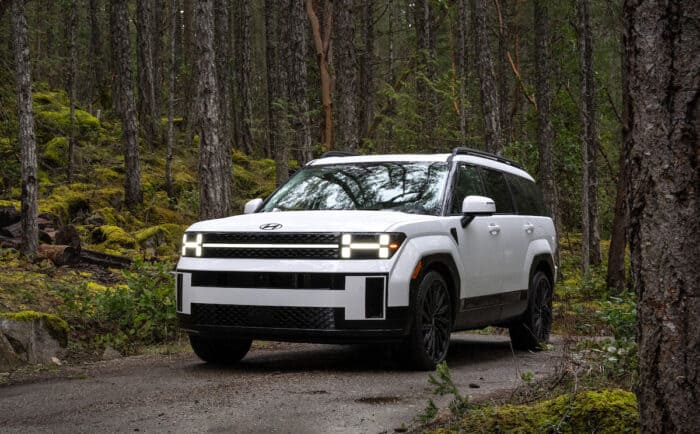
Pros
- Edgy styling
- Slightly more spacious than Sorento
- Wide tailgate opening
Cons
- Looks not for everyone
- Still no need for huge wheels
- C$1,500 is a lot for a fancy colour
There are no losers here. The Sorento has long been great value, particularly as comparatively few rivals offer three-row accommodation. The latest incarnation does everything it should, but we’d choose a hybrid powertrain – and, therefore, a lesser grade – over the gas-only X-Line Limited tested here.
Meanwhile, Santa Fe, which consistently outsells the Sorento in the US and Canada, justifiably remains a fierce competitor. The latest generation – made, like the Sorento, in the US – adds distinctive looks and three-row practicality to an already popular package. Again, the 2.5-turbo is your only option in this spec, but we think a hybrid makes more sense.
The choice is therefore a personal one: we recommend you test drive them both. Which one appeals to you more? Please take a closer look at their SUV lineups here:

